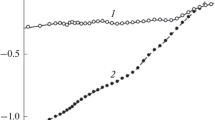Abstract
We have studied heterogeneous nucleation of liquid 4He on cesiated surfaces using calorimetric techniques. Nucleation kinetics are strongly influenced by wetting properties. Since liquid 4He does not wet cesium below 2K, substantial supercooling of the vapor is expected on theoretical grounds. Experimentally, however, we have been unable to detect any supercooling in our cells. This may be due to microscopic defects in the Cs coating, which in turn may be related to the fact that we have been unable to find a cell construction material which is wetted by Cs. Somewhat paradoxically, it is possible to supercool helium vapor even in a container made of conventional wetted materials by imposing a large heat and mass flux from the liquid to the vapor across the bulk liquid-vapor interface. When evaporation is sufficiently strong, the vapor above the liquid becomes unstable, and forms a dense fog. Videos of this process show that the fog front propagates rapidly from very near the liquid-vapor interface upward into the vapor. Fog formation near the liquid interface implies that the vapor is in a supercooled metastable state. Qualitative ideas from non-equilibrium thermodynamics and kinetic theory are used to explain this phenomenon.
Similar content being viewed by others
REFERENCES
M. S. Pettersen, S. Balibar and H. J. Maris, Phys. Rev. B 49, 12062 (1993).
X. Chavanne, S. Balibar and F. Caupin, Phys. Rev. Lett. 86, 5506 (2001).
J. P. Ruutu, P. J. Hakonen, J. S. Penttila, A. N. Babkin, J. P. Saramaki and E. B. Sonin, Phys. Rev. Lett. 77, 2514 (1996).
E. Tanaka, K. Hatakeyama, S. Noma, S. N. Burmistrov and T. Satoh, J. Low Temp. Phys. 127, 81 (2002).
M. Pettersen and W. Saam, Phys. Rev. B 51, 15369 (1995).
H. Kim, K. Seo, B. Tabbert and G. A. Williams, Euro. Phys. Lett. 58, 395 (2002).have also made helium fog using a completely different acoustic technique.
L. Waldmann and R. Rubsamen, Z. Naturforsh. 27, 1025 (1972).
H. Weichem, J. Phys. C 9, 553 (1976).
Y. Onishi and Y. Sone, J. Phys. Soc. Japan 47, 1697 (1979).
Author information
Authors and Affiliations
Rights and permissions
About this article
Cite this article
Burton, J., Nguyen Le, A.T., Rutledge, J.E. et al. Supercooling Helium Vapor: Nucleation and Fog Formation Induced by Strong Evaporation. Journal of Low Temperature Physics 134, 275–280 (2004). https://doi.org/10.1023/B:JOLT.0000012567.24143.e9
Issue Date:
DOI: https://doi.org/10.1023/B:JOLT.0000012567.24143.e9




